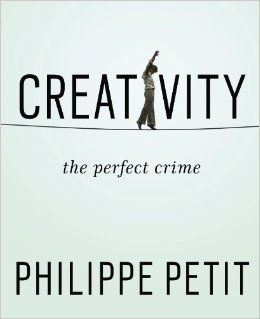In 1974, Phillipe Petit illegally walked a tight rope between the Twin Towers of the World Trade Center and set himself apart with his unique formula of boldness and skill. With the fame of such an audacious feat and the many other impressive talents he possesses, Petit began a speaking tour presenting his approach to creative problem solving. It was received with such enthusiasm that he decided write a book on creativity, despite his own criticism of books written on that subject. The title, CREATIVITY: the perfect crime, demonstrates his ability to be as daring with this theme as he is on a tight wire.
In CREATIVITY: the perfect crime Petit takes you through the history of reaching his dreams, describing both the challenges and successes he faced. He has a unique way of looking at challenges and how to defeat them. Petit confesses that he has “down to earth” fears; they are creatures with too many legs, or no legs at all—and when he is ready to conquer them, he knows how to proceed. He watches documentaries, reads science reports and goes to the zoo. He learns what scares his monsters, and in the process, he becomes James Bond, having no problem with letting tarantulas dance on his forearm. (Bond film enthusiasts will appreciate his analogy!)
Petit is not a spur-of-the-moment attention seeker as it might appear from his devil-may-care stunts; but rather, spends considerable time preparing for his successes. He practices and keeps a daily log. In this memoir he shares the six year process that prepared him to walk for the Twin Towers tight rope walk.
I found the spirit and personality of Petit every bit as interesting as the stories he tells. He is clever, witty, and serious; for good art is a very serious undertaking. Within the stories of CREATIVITY, you find yourself believing in your own dreams. There is something inspiring and motivating about learning how someone has achieved greatness; there is a certain level of cheerleading, a subliminal “you can do it!” message when witnessing seemingly impossible accomplishments from behind the scenes.
Petit does an excellent job of showing the importance of holding on to and accomplishing your dreams. As he shares, “Funny, it’s when I stop running that I suddenly feel like an outlaw ‘on the run.’ My edict is, ‘Keep going!’” He encourages us to never lose hope, because that is when the journey stops. Sometimes humans even die if they give up their dreams. After being arrested at the top of the World Trade Center Petit felt he was losing his dream and he went on to other goals for a while. But he never gave up, and ultimately came back to fulfill his vision.
In this book, you’ll be taken inside the mind of a highly unusual artist. Phillipe Petit is a creative genius who takes on challenges with the spirit of a rebel, is willing to do whatever it takes to succeed, even if it means breaking a few laws. It is not a well organized journey, but then creativity is often a process of imagination and chaos rather than rule keeping and following. If you are looking for a clear how-to book on the innovative process, this is not it. However, if you are interested in discovering the ideas, beliefs and methods of a man who has accomplished feats few would dare consider, let alone try, then you are going to be delighted with the stories and ideas that fill the pages of CREATIVITY: the perfect crime.

